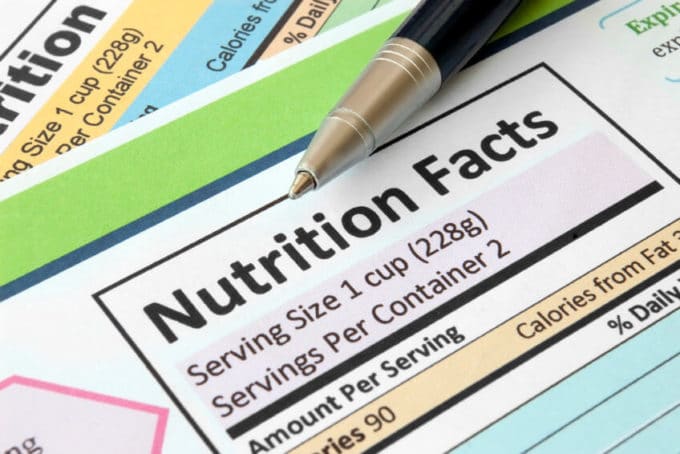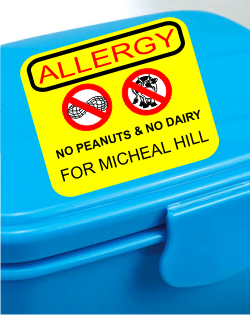43 hidden allergens are always listed on labels
Which Allergens Are in Your Food? You Can't Always Tell From the Labels It's easy to tell when certain allergens are present Congress passed the Food Allergen Labeling and Consumer Protection Act in 2004, a rule book for manufacturers. Companies must tell consumers if... How to Identify Gluten on Food Labels - Verywell Health Jan 30, 2022 · People who need to avoid gluten usually know to check food labels for “wheat.” You may need to read labels more carefully, though, to find other ingredients that contain gluten. Check for grains that are forms of wheat or which are made from wheat such as malt and farina. Also look for colorings, flavorings, or other additives.
Manner of declaring - List of ingredients and allergens on ... The following foods must always be listed by name in the list of ingredients when they are present in the foods listed in the Table A: Ingredients exempt from component declaration and the preparations and mixtures listed in Table B: Preparations exempt from a component declaration [B.01.009(4), FDR].

Hidden allergens are always listed on labels
Understanding Sesame Allergies: Symptoms, Treatment, and More 08.12.2017 · Sesame is a common hidden allergen, however. It’s not always listed on the food labels of products that contain it. Avoid foods that have product labels that are unclear or … FDA takes first step to labeling food for sesame allergy Oct. 29, 2018, 8:17 AM PDT. By Maggie Fox. The Food and Drug Administration took its first step Monday to requiring food labels to warn people if a product contains sesame. The agency is ... Food labels & nutritional information | Raising Children Network Sep 23, 2020 · The nutritional information on food labels helps you work out how healthy a food is. But keep in mind that some of the healthiest foods can be unlabelled – fresh fruit and vegetables, wholegrain breads, nuts, lentils, beans, fresh lean meats and fish. Ingredients on food labels. In Australia, food manufacturers must be truthful on their food ...
Hidden allergens are always listed on labels. Tips for Avoiding Hidden Food Allergens | MyFoodAllergyTeam "The labels list it as spices or seasonings." Spices or seasonings could also include garlic or herbs. Natural flavors/flavoring: "I avoid anything that says 'natural flavors' because you never know what's in them," a member wrote. While paying strict attention to food labels is time-consuming, some members see a silver lining. Food labels & nutritional information | Raising Children Network 23.09.2020 · The nutritional information on food labels helps you work out how healthy a food is. But keep in mind that some of the healthiest foods can be unlabelled – fresh fruit and vegetables, wholegrain breads, nuts, lentils, beans, fresh lean meats and fish. Ingredients on food labels. In Australia, food manufacturers must be truthful on their food ... Milk | Food Allergy Research & Education Milk is one of the eight major allergens that must be listed in plain language on packaged foods sold in the U.S., as required by federal law, either within the ingredient list or in a separate “Contains” statement on the package. This makes it easy to see if milk is present in a food item. As a general tip, ingredients are listed on the package in order of their prevalence in the … Manner of declaring - List of ingredients and allergens on food labels … Therefore, if any food allergens, gluten or added sulphites are present in these coatings, they must be declared on the labels of prepackaged fruits and vegetables. As wax coatings and other protective edible coatings are exempt from being declared as ingredients and components as per B.01.008(3)(a) of the FDR, the other components of these coatings are still exempt from …
Spices and Food Allergy - Kids With Food Allergies Sesame allergy is one of the most common food allergies in the United States. Sesame is a seed, but it is common in spice blends. A sesame allergy can cause anaphylaxis. If you have a sesame allergy, read labels carefully on spice blends. Until 2023, sesame does not need to be clearly labeled on packaged foods in the United States. Food Allergy & Anaphylaxis | Food Labeling | Food Labels Carefully check items that are labeled "nut." The U.S. Food and Drug Administration (FDA) classifies several items as "tree nuts" that are fruits, not tree nuts. These include coconut, lichee nut, shea nut, and Ginko nut. If you have tree nut allergies, talk with your board-certified allergist about whether to avoid these foods. Sesame | Food Allergy Research & Education To prevent a reaction, it is very important to avoid sesame. Sesame ingredients can be listed by many uncommon names. Always read food labels and ask questions about ingredients before eating a food that you have not prepared yourself. Avoid foods that contain sesame or any of these ingredients: Benne, benne seed, benniseed; Gingelly, gingelly oil Don't Be Fooled by Food Labels - WebMD If it's labeled "natural," it's healthier. a. True. b. False. Sources | Medically Reviewed on August 02, 2021. This tool does not provide medical advice. See additional information.
Avoiding Hidden Allergens | Always Food Safe - Food Manager ... Checking the Label. The most important thing to do when trying to avoid an allergen is to check the label carefully. The USDA requires that the 8 major food allergens be listed in plain English on the label. Labels will also mention if there could be traces of a certain allergen or if it was produced at the same facility as one. 38 Foods Where Gluten May Be "Hidden" The Food Allergen Labeling and Consumer Protection Act of 2004 (FALCPA) identified eight foods as major food allergens: milk, eggs, fish, shellfish, tree nuts, peanuts, wheat, and soybean. If you're sensitive to gluten derived from wheat, barley, and rye, you must be more diligent about reading food labels. How to Read a Food Label | Food Allergy Research & Education While all ingredients in a food are supposed to be listed in the ingredients list, FALCPA covers only the eight most common allergens. These are milk, egg, peanut, tree nuts, soy, wheat, fish and crustacean shellfish. Note that molluscan shellfish—such as oysters, clams, mussels or scallops—are not required to be labeled as a major allergen. Food Allergies | FDA This law identified eight foods as major food allergens: milk, eggs, fish, shellfish, tree nuts, peanuts, wheat, and soybeans. Eight foods are identified as major food allergens. Under the FASTER...
List of ingredients and allergens on food labels - Food ... The Food and Drug Regulations specify the manner in which ingredients and components must be declared, including grouping sugars-based ingredients, common names, and declaring food allergens, gluten and added sulphites. For further details, refer to Manner of declaring. Exemptions Prepackaged products that do not require a list of ingredients
Milk | Food Allergy Research & Education To prevent a reaction, it is very important that you avoid cow’s milk and cow’s milk-containing food products. Always read food labels and ask questions about ingredients before eating a food that you have not prepared yourself. If you are allergic to cow’s milk, your doctor may recommend you also avoid milk from other domestic animals.
Pandemic-Inspired Food Labeling Raises Alarms for Those With Food Allergies The top eight recognized food allergens in the U.S. — milk, eggs, fish, shellfish, peanuts, tree nuts, wheat and soy — as well as other priority allergens, including sesame, celery, lupin (a...
Foods to Avoid When You Have a Shellfish Allergy 26.10.2021 · If you're allergic to shellfish, you need to be extremely careful with the food you eat. Fortunately, shellfish can be easier to avoid than some other allergens. This is because they're an expensive ingredient. And they are usually not hidden in ingredient lists on food labels or restaurant menus.
How to Read an Ingredients Label for Food Allergies The Food Allergy Labeling and Consumer Protection Act (FALCPA) became effective in 2006 and requires the top 8 food allergens ( milk, soy, egg, wheat, peanut, tree nut, fish, and shellfish) be highlighted separately on the ingredients label in plain, easy-to-understand language.
Hidden Food Allergens: Are Food Labels Reliable? - WebMD The Food Allergen Labeling and Consumer Protection Act requires food manufacturers to clearly indicate when they've used one of eight major allergens: milk, eggs, fish, shellfish, peanuts, tree...
How to Identify Gluten on Food Labels - Verywell Health 30.01.2022 · People who need to avoid gluten usually know to check food labels for “wheat.” You may need to read labels more carefully, though, to find other ingredients that contain gluten. Check for grains that are forms of wheat or which are made from wheat such as malt and farina. Also look for colorings, flavorings, or other additives. These can ...
Hidden Dairy: Foods, Medication, and Beyond - Go Dairy Free By Alisa Fleming on May 16, 2006 Food Label Info There are the obvious dairy foods such as cow's milk (chocolate, whole, skim, malted, evaporated, etc.), buttermilk, half and half, cream, butter, cheese, ice cream, milk shakes, and yogurt. However, did you know that the majority of processed foods also contain dairy?
Top Food Allergens and Hidden Sources | For Better | US News With a wheat allergy, you can still eat other grains such as barley, corn, rye, oats, rice and quinoa. Foods to avoid: flour, couscous, farro, bread crumbs, bulgur, seitan, semolina and food ...
Dietitian says food labels may have hidden ingredients - KMTV People with food allergies may be at risk because of the unknown ingredients packed into one term. The top 8 allergens, which are milk, eggs, fish, shellfish, tree nuts, peanuts, wheat, and soybeans, are always listed separately on the food label. However, people with uncommon food allergies may not know if it's in their food.
Cleaning Supplies: Secret Ingredients, Hidden Hazards EWG research into more than 2,000 common cleaning products lays bare the troubling consequences of the lack of federal oversight over the ingredients in cleaning supplies. Manufacturers can use nearly any substance they want, even those known to pose health or environmental hazards. And they can hide information about virtually all those ...
Top Allergens: Places Where They Hide - Allergic Living deep fryers (used to cook fish, shrimp as well as other foods) glucosamine and some calcium supplements (shellfish) Omega 3 supplements. kamaboko. Fruits, Vegetables (Oral allergy syndrome or IgE-mediated allergy) flavorings and spices. colorings. salads (may contain raw fruit or vegetables) spreads.









Post a Comment for "43 hidden allergens are always listed on labels"